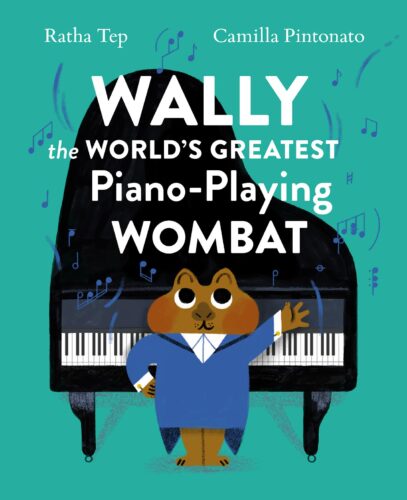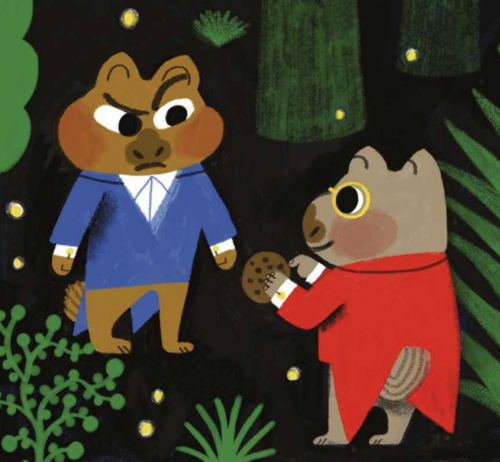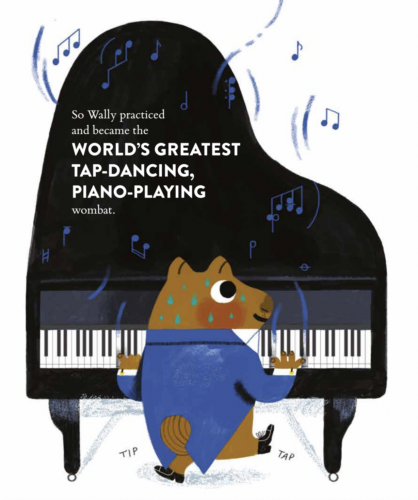Wombat Season Is Nigh: An Interview with Ratha Tep About WALLY, THE WORLD’S GREATEST PIANO-PLAYING WOMBAT
Wombats, man. They’re everywhere this year. Whether they’re opening their homes to their neighbors or getting munched by giant predators (check out Melissa Stewart’s Mega-Predators of the Past if you don’t believe me), they’re everywhere. What haven’t we seen them do yet? Play a concerto. Welp, knock that one off of your bingo card because thanks to the literary stylings of Ratha Tep we have, for your reading pleasure, WALLY, THE WORLD’S GREATEST PIANO-PLAYING WOMBAT. And, yes, I am going to list the publisher’s description:
“When Wally, the world’s greatest piano-playing wombat, hears Wylie play, he becomes envious. Wally tries toe-tapping and ball-twirling as he plays piano, but every time Wally thinks he’s one-upping the competition, he discovers Wylie can do all the same tricks.
Although Wally is discouraged at first, he soon realizes that competing with Wylie inspires them both to play better. And finding a friend to share what you love? That’s the best win of all. Both affirming and motivating, Wally’s story will resonate with young readers as they learn how to deal with competition and to do what makes them happy—even when they’re not the very best.”
He’s a wombat.
He’s playing a piano.
I have some questions.
Betsy Bird: Ratha! Thank you so much for answering my questions today! I’ve a plethora of different questions to ask you about your debut picture book, but let’s be gauche and ask the obvious right from the start: How did you come up with the idea for WALLY in the first place?
ADVERTISEMENT
ADVERTISEMENT

Ratha Tep: Hi Betsy! Thanks so much for having me! It’s such an incredible honor to be here.
The idea for WALLY stemmed from my two daughters and their very different first experiences playing the piano. My older daughter, who was six at the time, picked it up quite fast, and—in the way some young kids can be prone to hyperbole—started claiming that she was the world’s greatest piano player. You can imagine how that made my younger daughter feel! She was only four then, and super intimidated at seeing her sister play so well. On the flip side, I started wondering how my older daughter would handle seeing someone who played better. I imagined she’d be envious for sure, but would it make her want to give up—or would it inspire her?
BB: Okay, I relate to this situation just a little too well. Betcha a bunch of parents will. Now I probably needn’t even tell you that WALLY is part of a wombat-trend here in 2022. This year alone we’re seeing Wombat Underground: A Wildfire Survival Story by Sarah L. Thomson, ill. Charles Santoso and Wombat Said Come In by Carmen Agra Deedy, ill. Brian Lies. What is it about wombats that’s just so darn irresistible these days?
RT: Wombats are indeed irresistible! I’m grateful to Jackie French and Bruce Whatley, whose Diary of a Wombat introduced the marsupial to an entire generation of American kids. Their eighth book in the series, Diary of a Rescued Wombat, is coming out in November, and I can’t wait to read it.

Wombat Underground and Wombat Said Come In were born from the stories of wombats sheltering other animals in their burrows during the recent Australian wildfires.
Wally, unfortunately, sheltered no one—unless you count his new pet fish.
I made Wally a wombat not for any benevolent quality of his, but for that extra dose of humor. The largest wombat species, the Northern hairy-nosed wombat—the ones I imagine would be able to reach piano keys—are extremely rare. There are only 315 of them left! So you would expect that ANY piano-playing Northern hairy-based wombat would be the world’s greatest, but lo and behold, there’s another one! And then… !
BB: Oh, man. I loved Diary of a Wombat back in the day. And I had no idea about Diary of a Rescued Wombat! News I can use! So Wylie turns out to be the inadvertent antagonist to Wally in this book. Wally is so focused on being the best that this aim for success blinds him to Wylie’s charms. When writing this book, did you give any thought to kids today and the degree to which they’re pressured to succeed at all costs?
RT: What a great question, Betsy! As I was writing Wally, it did dawn on me that I was an Asian-American mom writing about my two piano-playing daughters (ahem, wombats), which might bring to mind Amy Chua and the firestorm that surrounded her Tiger Mom-parenting style. But Wally is precisely the opposite. I wanted to show kids that you don’t need to be the world’s greatest anything. You don’t need to make it to Carnegie Hall at 14!

I think a lot of this pressure on kids comes from parents, with Mom-guilt and fomo feeding into it. Sadly, this parental pressure has led to a rise in anxiety and mental health issues. My kids, after their initial enthusiasm with the piano, actually started saying they hated it. It turned out what they hated was the pressure of their weekly lessons and mandatory practice. So my husband and I pulled a radical Jellyfish parenting move: We let them quit! And you know what? They picked the piano right back up, but on their own terms, and are back to loving it.
BB: Aww. As the parent of a daughter who just quit piano too, I feel this. And I’m always fascinated by the process of pairing an author’s words with an illustrator’s art. Did you have a particular look to the book in your mind as you wrote it? How did you feel when you saw Camilla Pintonato’s art for the first time?
ADVERTISEMENT
ADVERTISEMENT
RT: Like every author, I did have a certain “look” in mind, but that look was blown away when I first saw Camilla’s renderings. There’s just so much energy and humor in her style. I’m also amazed at how she was able to capture such a huge range of wombat expressions. And having Wally poke out from the page? Genius. Camilla’s art really punched the book to another level.

BB: Is this the last we’ll see of Wylie, Wally, and that mysterious wombat at the end of the book? Or would you possibly consider a kind of sequel?
RT: I loved dreaming up Wally and Wylie and their over-the-top antics, and can definitely see them having more fun together. But for now, I’m just excited to introduce them to the world!
BB: Finally, what are you working on next?
RT: I’m working on a few projects that I can’t quite share yet, but hopefully I’ll get another invitation to come back here to talk to you about them when the timing is right!
BB: Done and done!
A great big thank you to Ratha for taking the time to answer all my questions here today. You’ll find WALLY , THE WORLD’S GREATEST PIANO-PLAYING WOMBAT on shelves October 18th. Be sure to look for it soon!
Filed under: Interviews
About Betsy Bird
Betsy Bird is currently the Collection Development Manager of the Evanston Public Library system and a former Materials Specialist for New York Public Library. She has served on Newbery, written for Horn Book, and has done other lovely little things that she'd love to tell you about but that she's sure you'd find more interesting to hear of in person. Her opinions are her own and do not reflect those of EPL, SLJ, or any of the other acronyms you might be able to name. Follow her on Twitter: @fuseeight.
ADVERTISEMENT
ADVERTISEMENT
SLJ Blog Network
One Star Review, Guess Who? (#202)
More Geronimo Stilton Graphic Novels Coming from Papercutz | News
Parsing Religion in Public Schools
Take Five: LGBTQIA+ Middle Grade Novels
ADVERTISEMENT







